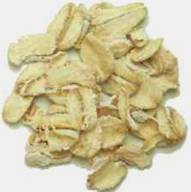Whole grain oats are cleaned and conditioned. It is then fed into an externally heated, sealed pressure chamber. Steam is injected to raise the internal pressure in the chamber to about 14 kg/cm2 and then suddenly released by opening the chamber which expands water vapour inturn the grain blows up to several times its original size.
Different types of processing are used to produce various types of oat products, which are generally used to make breakfast cereals, baked products and stuffings
-
Oat groats: Oat grain that have been hulled (unflattened kernels that are good for breakfast cereal or for stuffing).
-
Steel cut oats: Groats that have been cut into 2 to 3 pieces and not rolled. They take considerably longer to cook than rolled oats and have a decidedly chewy texture. It is also called as scotch oats or Irish oatmeal.
-
Rolled oats: Oat groats when steamed and flattened with huge rollers, it becomes regular rolled oats. They take about 15 minutes to cook.
-
Quick cooking rolled oats: Oat groats that have been cut into several pieces before being steamed and rolled into thinner flakes. They take about 5 minutes to cook.
-
Instant oats: Cut groats that have been precooked and dried before being rolled. This precooking process softens the oat pieces that, often being combined with a liquid; the mixture can turn baked goods such as muffins or cookies into gooey lymps. Most instant oatmeal is packaged with salt, sugar and other flavours.
-
Oat flour: Oat groats that have been ground into powder.
-
Oat bran: It is the outer casing of oats and is particularly high in soluble fiber thought to be a leading contender in the fight against high cholesterol.
VALUE ADDITION
Some oat products such as chappathi, extruded products (noodles, vermicelli and macaroni), pittu, adai, sweet and chilli biscuits and health drink with different milled oat products and with different proportions was developed. Results of the study showed that, chappathi made from 75% oat flour with 25% wheat flour was highly acceptable. Extruded products and pittu made from 100% oat flour was highly acceptable. Oats adai made from oats flour with green gram flour had good consumer acceptability. Biscuits made from 30% oat bran had good acceptability and health drink made from incorporating 10% oat bran into milk was possible.

